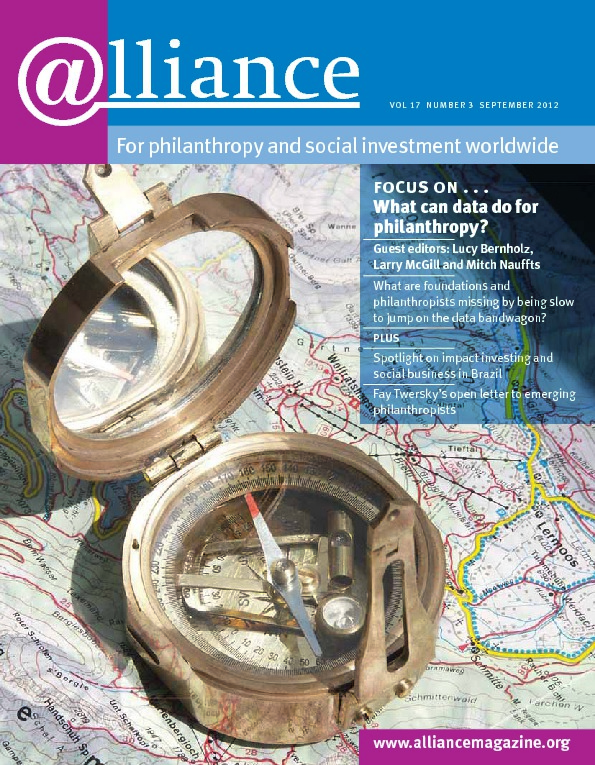As an emerging investment strategy, impact investing has had to work hard to gain the trust of actors both in the impact sector and in traditional financial markets. Data have played an immense role in creating the track record necessary to facilitate trust and persuade the initially not-so-convinced investors and funders that impact investing, although risky, can produce the goods. But data are not the be all and end all of reporting impact.
 Producing the data to prove impact is tricky. To motivate investment, social businesses need to show that they have achieved a positive social or environmental impact so that investors will gain a social return in addition to their financial return. Numerous measurement and reporting tools have been designed such as GIIRS (Global Impact Investing Rating System) and SROI (Social Return on Investment). However, the sheer diversity of mission and impact that exists in the impact investing sector makes recording comparable data near impossible. Social business A may have a greater environmental or social impact than social business B, but because B’s outcomes are more easily measured, it may be perceived as having a greater impact.
Producing the data to prove impact is tricky. To motivate investment, social businesses need to show that they have achieved a positive social or environmental impact so that investors will gain a social return in addition to their financial return. Numerous measurement and reporting tools have been designed such as GIIRS (Global Impact Investing Rating System) and SROI (Social Return on Investment). However, the sheer diversity of mission and impact that exists in the impact investing sector makes recording comparable data near impossible. Social business A may have a greater environmental or social impact than social business B, but because B’s outcomes are more easily measured, it may be perceived as having a greater impact.
The problem is that ‘hard’ data alone do not truthfully reflect reality. Furthermore, when you exclude the narrative you may overlook issues such as relative location, access or even urgency addressed by social business A which would make its impact even more compelling in the circumstances. Circumstances become black holes without the narrative. These holes in the data net are becoming increasingly obvious and are problematic when it comes to using data to attract resources.
Standardized, sanitized reporting removes the uniqueness that stories and an understanding of the beneficiaries’ experience provide. While impact investors want to ensure that their financial returns will not be compromised, they want to be clear that their investment has made a significant and positive difference in people’s lives. These ‘stories’ ultimately provide the narrative of impact and may well be the defining experience for impact investors in a world where financial return is easily measured and quantifiable but social impact is harder to discern. Mark van Wyk, portfolio manager of a GIIRS-rated fund at Mergence Investment Managers, illustrates this point: ‘Data may not paint a complete picture of impact, but the narrative, the experience of beneficiaries and staff, provides another perspective and a clearer understanding of tangible and intangible impact.’
David Bonbright of Keystone Accountability helped to develop IPAL, an impact reporting tool that values feedback from constituents. Bonbright argues that the voices of the beneficiaries of an impact investment are the most overlooked and undervalued piece of the impact reporting puzzle. The IPAL tool uses beneficiary feedback to determine whether money spent is actually achieving the intended purpose. When you know the questions to ask and get this sort of feedback, you can predict where changes in intervention or service delivery can take you. Thus, feedback from constituents today will correlate to impact achieved tomorrow.
Nexii, a social business that provides specialist support and advisory services related to impact investment, manages the world’s first social stock exchange, the iX, in collaboration with the Stock Exchange of Mauritius. Our experience attests to the power of stories in understanding the real experience of impact investments at a ground level. Take the case of a social business, seeking to list with iX, that provides small micro-loans to rural women to increase their enterprise activities. One beneficiary of this programme, a woman on her fourth loan, had a significant growth in turnover, clearly producing a positive financial return for her and for her investors. However, on the face of it there was little evidence of any other significant change in her life. The director of the organization therefore decided to visit her. Noticing no specific improvement in her living conditions, he turned to the field officer, who pointed out that she had put up a fence round her garden so that the goats were no longer able to destroy her crops. That was the reason for a tripling of her produce over the period. Unseen perhaps to the data. Visible in the narrative.
Stories of impact and tools like IPAL go beyond cosmetic reflections by incorporating the voice and value of those who experience the impact. If data alone provide an incomplete and problematic understanding, a combination of narrative and data is vital in reflecting the true impact of an impact investment.
Kelly Notcutt is head of Strategic Communications at Nexii. Email kelly@nexii.com.
Tamzin Ractliffe is the founder and CEO at Nexii. Email tamzin@nexii.com.





Comments (0)